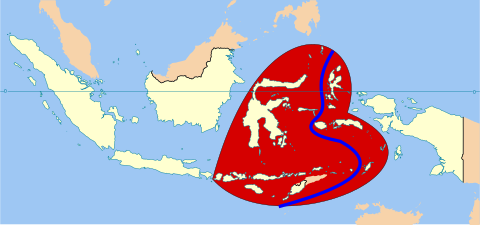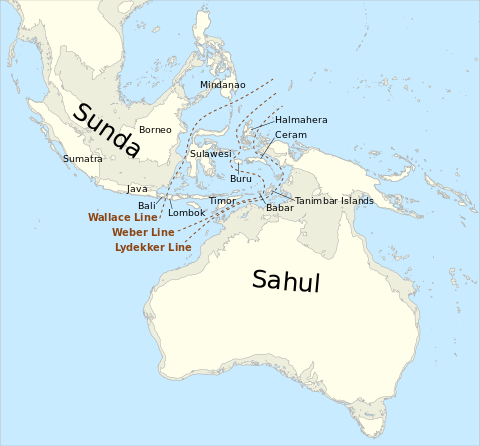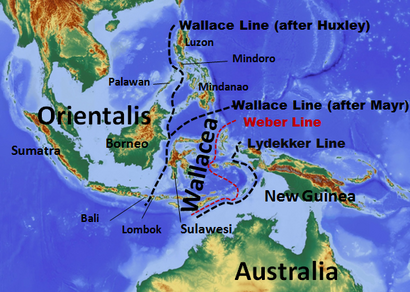والاسيا

Wallacea /wɒˈleɪsiə/ is a biogeographical designation for a group of mainly Indonesian islands separated by deep-water straits from the Asian and Australian continental shelves. Wallacea includes Sulawesi, the largest island in the group, as well as Lombok, Sumbawa, Flores, Sumba, Timor, Halmahera, Buru, Seram, and many smaller islands. The islands of Wallacea lie between the Sunda Shelf (the Malay Peninsula, Sumatra, Borneo, Java, and Bali) to the west, and the Sahul Shelf including Australia and New Guinea to the south and east. The total land area of Wallacea is 347,000 km2 (134,000 sq mi).[1]
. . . . . . . . . . . . . . . . . . . . . . . . . . . . . . . . . . . . . . . . . . . . . . . . . . . . . . . . . . . . . . . . . . . . . . . . . . . . . . . . . . . . . . . . . . . . . . . . . . . . . . . . . . . . . . . . . . . . . . . . . . . . . . . . . . . . . . . . . . . . . . . . . . . . . . . . . . . . . . . . . . . . . . . .
الجغرافيا
Wallacea is defined as the series of islands stretching between the two continental shelves of Sunda and Sahul, but excluding the Philippines. Its eastern border (separating Wallacea from Sahul) is represented by a zoogeographical boundary known as Lydekker's Line, while the Wallace Line (separating Wallacea from Sunda) defines its western border.[2][3]
The Weber Line is the midpoint, at which Asian and Australian fauna and flora are approximately equally represented. It follows the deepest straits traversing the Indonesian Archipelago.
خط والاس مسمى على اسم عالم الطبيعيات الويلزي ألفرد رسل والاس، الذي سجل الفروق بين وحيش (ثدييات وطيور) الجزر على جانبي الخط. The islands of Sundaland to the west of the line, including Sumatra, Java, Bali, and Borneo, share a mammal fauna similar to that of East Asia, which includes tigers, rhinoceros, and apes; whereas the mammal fauna of Lombok and areas extending eastwards are mostly populated by marsupials and birds similar to those in Australasia. Sulawesi shows signs of both.[4]
During the ice ages, sea levels were lower, exposing the Sunda shelf that links the islands of Sundaland to one another and to Asia[5] and allowing Asian land animals to inhabit these islands.
The islands of Wallacea have few land mammals, land birds, or freshwater fish of continental origin, which find it difficult to cross open ocean. Many species of birds, reptiles, and insects were better able to cross the straits, and many such species of Australian and Asian origin are found there. Wallacea's plants are predominantly of Asian origin, and botanists include Sundaland, Wallacea, and New Guinea as the floristic province of Malesia.[بحاجة لمصدر]
Similarly, Australia and New Guinea to the east are linked by a shallow continental shelf, and were linked by a land bridge during the ice ages, forming a single continent that scientists variously call Australia-New Guinea, Meganesia, Papualand, or Sahul. Consequently, Australia, New Guinea, and the Aru Islands share many marsupial mammals, land birds, and freshwater fish that are not found in Wallacea.[3]
Biota and conservation issues
Although the distant ancestors of Wallacea's flora and fauna may have been from Asia or Australia-New Guinea, Wallacea is home to many endemic species. There is extensive autochthonous speciation and proportionately large numbers of endemics; the area is an important contributor to the overall mega-biodiversity of the Indonesian Archipelago.[6]
Fauna includes the lowland and mountain anoa, or dwarf buffalo (Bubalus sp.), and the babirusa, or "deer-pig" (Babyrousa sp.), both found on Sulawesi, among other islands. Maluku shares a number of similar species with Sulawesi, albeit with fewer total, given the differences in size between the two islands—Sulawesi has at least 4,000 recorded terrestrial plant and animal species,[7] while Maluku has just over 1,000, by comparison. Sulawesi is home to over 2,000 invertebrate species (with over 1,000 known species of arthropod, not including nearly 900 lepidopterans), 100 species of reptiles and amphibians, and 288 bird species. Maluku has around 70 reptile and amphibian, 250 avian, and over 550 invertebrate species. Seram Island is particularly noted for its butterflies and birds, including the Moluccan king parrot. Smaller mammals, including some carnivorans (such as civets), marsupials (such as the cuscus), primates and rodents are common throughout the region.
A large portion of the waters surrounding Wallacea are part of the Coral Triangle, considered to be the richest coral reef and marine ecosystems on earth, with the highest number of species, adding to the total biodiversity of the region.
Wallacea was originally almost completely forested, mostly tropical moist broadleaf forests, with some areas of tropical dry broadleaf forest. The higher mountains are home to montane and subalpine forests, and mangroves are common in coastal areas. According to Conservation International, Wallacea is home to over 10,000 plant species, of which approximately 1,500 (15%) are endemic.[1]
Endemism is higher among terrestrial vertebrate species; out of 1,142 species described there, almost half (529) were endemic. 45% of the region retains some sort of forest cover, though only 52,017 km2 (15%) is in a pristine state. Of Wallacea's total 347,000 km2-area, about 20,000 km2 are protected.[1]
Wallacea is home to 82 threatened and six critically endangered species of terrestrial vertebrates.[بحاجة لمصدر]
Ecoregions
Tropical and subtropical moist broadleaf forests:
- Banda Sea Islands moist deciduous forests (Kai Islands, Tanimbar Islands, Babar Islands, Leti Islands, eastern Barat Daya Islands)
- Buru rain forests (Buru)
- Halmahera rain forests (Halmahera, Morotai, Obi Islands, Bacan Island)
- Seram rain forests (Seram, Banda Islands, Ambon Island, Saparua, Gorong archipelago)
- Sulawesi lowland rain forests (Sulawesi, Banggai Islands, Sula Islands, Sangihe Islands, Talaud Islands)
- Sulawesi montane rain forests (Sulawesi)
Tropical and subtropical dry broadleaf forests:
- Lesser Sundas deciduous forests (Lombok, Sumbawa, Komodo, Flores, Alor)
- Sumba deciduous forests (Sumba)
- Timor and Wetar deciduous forests (Timor, Wetar)
Distribution between Asia and Australia
Australia may be isolated by sea, but technically through Wallacea, it can be zoologically extended. Australian Early-Middle Pliocene rodent fossils have been found in Chinchilla Sands and Bluffs Down in Queensland, but a mix of ancestral and derived traits suggest murid rodents made it to Australia earlier, maybe in the Miocene, over a forested archipelago, i.e. Wallacea, and evolved in Australia in isolation.[8]
Australia's rodents make up much of the continent's placental mammal fauna and include various species from stick-nest rats to hopping mice. Other mammals invaded from the east. Two species of cuscus, the Sulawesi bear cuscus and the Sulawesi dwarf cuscus, are the westernmost representatives of the Australasian marsupials.[9]
The tectonic uplift of Wallacea during the collision between Australia and Asia ح. 23 million years ago allowed the global dispersal of passerine birds from Australia across the Indonesian islands.[10] Bustards and megapodes must have somehow colonized Australia. Cockatiels similar to those from Australia inhabit Komodo Island in Wallacea.[بحاجة لمصدر]
A few species of Eucalyptus, a predominant genus of trees in Australia, are found in Wallacea: Eucalyptus deglupta on Sulawesi, and E. urophylla and E. alba in East Nusa Tenggara.[11] For land snails Wallacea and Wallace's Line do not form a barrier for dispersal.[12]
المراجع
- ^ أ ب ت Myers, N.; Mittermeier, R. A.; Mittermeier, C. G.; Da Fonseca, G. A; Kent, J. (2000). "Biodiversity hotspots for conservation priorities" (PDF). Nature. 403 (6772): 853–857. Bibcode:2000Natur.403..853M. doi:10.1038/35002501. PMID 10706275. S2CID 4414279. Retrieved 15 September 2019.
- ^ Kealy, Shimona; Louys, Julien; o'Connor, Sue (2015). "Islands under the sea: a review of early modern human dispersal routes and migration hypotheses through Wallacea". The Journal of Island and Coastal Archaeology. 11 (3): 364–84. doi:10.1080/15564894.2015.1119218. S2CID 129964987.
- ^ أ ب New, T.R. (2002). "Neuroptera of Wallacea: a transitional fauna between major geographical regions" (PDF). Acta Zoologica Academiae Scientiarum Hungaricae. 48 (2): 217–27.
- ^ Wallace, Alfred Russel (1869). "Physical Geography". The Malay Archipelago. New York: Harper & Brothers. pp. 23–30.
- ^ "Pleistocene Sea Level Maps". The Field Museum. 12 January 2011. Archived from the original on 17 March 2009. Retrieved 15 September 2019.
- ^ Rhee, S.; Kitchener, D.; Brown, T. et al., eds. Report on Biodiversity and Tropical Forests in Indonesia. pp. 3–2. Archived from the original. You must specify the date the archive was made using the
|archivedate=parameter. https://pdf.usaid.gov/pdf_docs/pnada949.pdf. - ^ "Observations - iNaturalist". iNaturalist. Retrieved 20 March 2024.
- ^ Archer, M.; Hand, S. J.; Godthelp, H. (2017). "Patterns in the history of Australia's mammals and inferences about palaeohabitats" (PDF). In Hill, R. S. (ed.). History of the Australian Vegetation: Cretaceous to Recent. University of Adelaide Press. pp. 80–103. ISBN 9781925261479. JSTOR 10.20851/j.ctt1sq5wrv.10. Retrieved 15 September 2019.
- ^ Rowe, K. C.; Reno, M. L.; Richmond, D. M.; Adkins, R. M.; Steppan, S. J. (2008). "Pliocene colonization and adaptive radiations in Australia and New Guinea (Sahul): multilocus systematics of the old endemic rodents (Muroidea: Murinae)" (PDF). Molecular Phylogenetics and Evolution. 47 (1): 84–101. doi:10.1016/j.ympev.2008.01.001. PMID 18313945. Retrieved 19 April 2019.
- ^ Moyle, R. G.; Oliveros, C. H.; Andersen, M. J.; Hosner, P. A.; Benz, B. W.; Manthey, J. D.; Travers, S. L.; Brown, R. M.; Faircloth, B. C. (2016). "Tectonic collision and uplift of Wallacea triggered the global songbird radiation". Nature Communications. 7 (12709): 12709. Bibcode:2016NatCo...712709M. doi:10.1038/ncomms12709. PMC 5013600. PMID 27575437.
- ^ Pramono, I. B.; Pudjiharta, A. (1996). 'Reports submitted to the regional expert consultation on eucalyptus'. II. Food and Agriculture Organization, Regional Office for Asia and the Pacific, Bangladesh.
- ^ Hausdorf, B. (2019). "Beyond Wallace's line – dispersal of Oriental and Australo-Papuan land-snails across the Indo-Australian Archipelago". Zoological Journal of the Linnean Society. 185 (1): 66–76. doi:10.1093/zoolinnean/zly031.
External links
- Conservation International: Wallacea
- "Too Many Lines; The Limits of the Oriental and Australian Zoogeographic Regions", George Gaylord Simpson, Proceedings of the American Philosophical Society, Vol. 121, No. 2 (Apr. 29, 1977), pp. 107–120
- Wallacea Research Group

